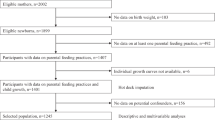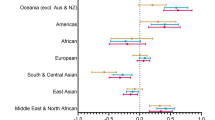Abstract
Background/objectives:
Childhood obesity rates differ between cultural groups in Europe. Parents influence their children’s weight status and eating behaviours through feeding practices. We investigated cultural differences in feeding practices and eating behaviours and their relation to child weight in three groups that differed in cultural background and geographical location.
Subjects/methods:
Fifty-two White German (WG) families, in Germany (44 mothers, mean age 33.8 years), 79 White British (WB) families, in the UK (74 mothers, mean age 37.8) and 40 Black Afro-Caribbean (BAC) families, in the UK (34 mothers, mean age 31.8) participated in this study of 2–12-year-old children. Parents completed questionnaires assessing feeding practices and eating behaviours; children were measured and weighed by experimenters.
Results:
MANCOVAs indicated that BAC parents used the highest levels of restrictive feeding practices and the lowest levels of monitoring, and their children showed the highest levels of food-approach behaviours. WG parents used the lowest levels of pressure to eat. Partial correlations showed that food-approach behaviours were correlated with child BMI in BAC and WG families but not in WB families. Parental restriction was associated with child Body Mass Index (BMI) in BAC families only.
Conclusions:
There are both similarities and differences in feeding practices and eating behaviours and their relationships with child weight in different cultural groups. Findings highlight the importance of being aware of cultural differences when carrying out research with multi-cultural samples in Europe.
This is a preview of subscription content, access via your institution
Access options
Subscribe to this journal
Receive 12 print issues and online access
$259.00 per year
only $21.58 per issue
Buy this article
- Purchase on Springer Link
- Instant access to full article PDF
Prices may be subject to local taxes which are calculated during checkout


Similar content being viewed by others
References
Birch LL, Fisher JO . Development of eating behaviours among children and adolescents. Pediatrics 1998; 101: 539–549.
Clark HR, Goyder P, Bissell P, Blank L, Peters J . How do parents’ child-feeding behaviours influence child weight? Implications for child obesity policy. J Public Health 2007; 29: 132–141.
Johnson SL, Birch LL . Parents’ and children’s adiposity and eating style. Pediatrics 1994; 94: 653–661.
Fisher JO, Birch LL . Eating in the absence of hunger and overweight in girls from 5 to 7 y of age. Am J Clin Nutr 2002; 76: 226–231.
Faith MS, Berkowitz RI, Stallings VA, Kerns J, Storey M, Stunkard AJ . Parental feeding attitudes and styles and child body mass index: prospective analysis of a gene environment interaction. Pediatrics 2004; 114: e429–e436.
Galloway AT, Fiorito LM, Francis LA, Birch LL . ‘Finish your soup’: counterproductive effects of pressuring children to eat on intake and affect. Appetite 2006; 46: 318–323.
Klesges RC, Stein RJ, Eck LH, Isbell TR, Klesges LM . Parental influence on food selection in young children and its relationships to childhood obesity. Am J Clin Nutr 1991; 53: 859–864.
Kumanyika SK . Environmental influences on childhood obesity: ethnic and cultural influences in context. Physiol Behav 2008; 94: 61–70.
Sproston K, Mindell JE Health Survey for England 2004: the health of minority ethnic groups. The Information Centre: London, 2006.
Whincup PH, Nightingale CM, Owen CG, Rudnicka AR, Gibb I, McKay CM et al. Early emergence of ethnic differences in type 2 diabetes precursors in the UK: the Child Heart Health Study in England (CHASE Study). PLoS Med 2010; 7: 1–10.
International Association for the Study of Obesity. Overweight and Obesity in the EU27 [Brochure]. London: Author 2008.
Kurth B-M, Schaffrath Rosario A Die Verbreitung von Übergewicht und Adipositas bei Kindern und Jugendlichen in Deutschland. Ergebnisse des bundesweiten Kinder- und Jugendgesundheitssurveys (KiGGS), in German. [The prevalence of overweight and obese children and adolescents living in Germany. Results of the German Health Interview and Examination Survey for Children and Adolescents (KiGGS)]. Bundesgesundheitsblatt Gesundheitsforschung Gesundheitsschutz 2007; 50: 736–743.
Crowther R, Dinsdale H, Rutter H, Kyffin R Analysis of the National Childhood Obesity Database 2005–06. A report for the Department of Health by the South Eats Public Health Observatory on behalf of the Association of Public Health Observatories. London: Department of Health 2007.
Bundesministerium für Ernährung, Landwirtschaft und Verbraucherschutz. Nationale Verzehrsstudie II, Ergebnisbericht Teil 1. Die bundesweite Befragung zur Ernährung von Jugendlichen und Erwachsenen, in German. (National study of consumption II, results part 1. The nationwide assessment of intake of adolescents and adults). Karlsruhe: Max Rubner-Institut, Bundesforschungsinstitut für Ernährung und Lebensmittel 2008.
The NHS Information Centre, Lifestyle Statistics. Statistics on obesity, physical activity and diet: England, February 2009. Leeds: The Health and Social Care Information Centre 2009.
Viana V, Sinde S, Saxton JC . Children’s eating behaviour questionnaire: associations with BMI in Portuguese children. Brit J Nutr 2008; 100: 445–450.
Webber L, Hill C, Saxton J, Van Jaarsveld CHM, Wardle J . Eating behaviour and weight in children. Int J Obesity 2009; 33: 21–28.
Child Growth Foundation Cross Sectional Stature and Weight Reference Curves for the UK. London, UK: Author 1996.
Dowler E, Calvert C . Looking for ‘fresh’ food: diet and lone parents. P Nutr Soc 1995; 54: 759–769.
Hodes M, Jones C, Davies H . Cross-cultural differences in maternal evaluation of children’s body shapes. Int J Eat Disorders 1996; 19: 257–263.
Pomerleau J, McKeigue PM, Chaturvedi N . Factors associated with obesity in South Asian, Afro-Caribbean and European women. Int J Obesity 1999; 23: 25–33.
Wardle J, Bindra R, Fairclough B, Westcombe A . Culture and body image: body perception and weight concern in young Asian and Caucasian British women. J Community Appl Soc Psychol 1993; 3: 173–181.
Jansen E, Mulkens S, Jansen A . Do not eat the red food!: prohibition of snacks leads to their relatively higher consumption in children. Appetite 2007; 49: 572–577.
Musher-Eizenman DR, Holub SC . Comprehensive feeding practices questionnaire: validation of a new measure of parental feeding practices. J Pediatr Psychol 2007; 32: 960–972.
Wardle J, Guthrie CA, Sanderson S, Rapoport L . Development of the children’s eating behaviour questionnaire. J Child Psychol Psyc 2001; 42: 963–970.
Wudy SA, Hagemann S, Dempfle A, Ringler G, Blum WF, Berthold LD et al. Children with idiopathic short stature are poor eaters and have decreased body mass index. Pediatrics 2005; 116: e52–e57.
Van Strien T, Frijters JER, Bergers GPA, Defares PB . The Dutch Eating Behavior Questionnaire (DEBQ) for assessment of restrained, emotional, and external eating behavior. Int J Eat Disorder 1986; 5: 295–315.
Wardle J . Eating Style: a validation study of the Dutch Eating Behvaiour Questionnaire in normal weight subjects and women with eating disorders. J Psychosom Res 1987; 31: 161–169.
Kräuchi K, Reich S, Wirz-Justice A . Eating style in seasonal affective disorder: who will gain weight in winter? Compr Psychiatr 1997; 38: 80–87.
Hughes SO, Power TG, Fisher JO, Mueller S, Nicklas TA . Revisiting a neglected construct: parenting styles in a child-feeding context. Appetite 2005; 44: 83–92.
Birch LL, Fisher JO, Davison KK . Learning to overeat: maternal use of restrictive feeding practices promotes girls’ eating in the absence of hunger. Am J Clin Nutr 2003; 78: 215–220.
Carper JL, Fisher JO, Birch LL . Young girls’ emerging dietary restraint and disinhibition are related to parental control in child feeding. Appetite 2000; 35: 121–129.
Farrow C, Blissett J . Stability and continuity of parentally reported child eating behaviours and feeding practices from 2 to 5 years of age. Appetite 2012; 58: 151–156.
Ashcroft J, Semmler C, Carmell S, van Jaarsveld CHM, Wardle J . Continuity and stability of eating behaviour traits in children. Eur J Clin Nutr 2008; 62: 985–990.
Golan M, Kaufman V, Shahar DR . Childhood obesity treatment: targeting parents exclusively v. parents and children. Brit J Nutr 2006; 95: 1008–1015.
Rosenkranz RR, Dzewaltowski DA . Model of the home food environment pertaining to childhood obesity. Nutr Rev 2008; 66: 123–140.
Acknowledgements
Acknowledgements to Amma Mensah for her role in data collection. We would like to thank Dr Andrea Krott for her help in translating the questionnaire.
Author information
Authors and Affiliations
Corresponding author
Ethics declarations
Competing interests
The authors declare no conflict of interest.
Rights and permissions
About this article
Cite this article
Blissett, J., Bennett, C. Cultural differences in parental feeding practices and children’s eating behaviours and their relationships with child BMI: a comparison of Black Afro-Caribbean, White British and White German samples. Eur J Clin Nutr 67, 180–184 (2013). https://doi.org/10.1038/ejcn.2012.198
Received:
Revised:
Accepted:
Published:
Issue Date:
DOI: https://doi.org/10.1038/ejcn.2012.198
Keywords
This article is cited by
-
Identifying and predicting food parenting practice profiles among Canadian parents
International Journal of Behavioral Nutrition and Physical Activity (2021)
-
Food, health, and complexity: towards a conceptual understanding to guide collaborative public health action
BMC Public Health (2016)



